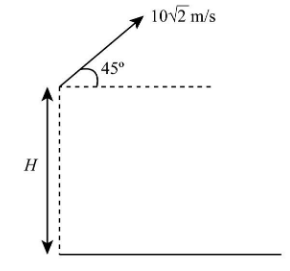Question
Question: A particle is projected with speed \[10\sqrt 2 {\rm{ }}{{\rm{m}} {\left/{\vphantom {{\rm{m}} {\rm{s}...
A particle is projected with speed 102m/mss making an angle 45∘ with horizontal in vertical xy-plane. After time t its velocity become perpendicular to its initial velocity, then the value of t is (g=10m/ms2s2).

Solution
We will write the initial and final velocity of the given particle in vector form. We know that the dot product of two perpendicular vectors is equal to zero. Using the concept of dot product, we will find the value of time t.
Complete step by step answer:
The speed of the given particle is u=102m/mss.
The angle made by a particle with the horizontal is θ=45∘.
The acceleration due to gravity is g=10m/ms2s2.
We can write the expression for velocity in vector form as below:
V=u(cosθi^+sinθj^)
Here i^ and j^ are unit vectors in x-direction and y-direction, respectively.
We will substitute 102 for u in the above expression to get the vector form of the initial velocity of the given particle.
We can write the expression for velocity after time t as below:
V′=[10i^+(10−gt)j^]
Here gt is the velocity due to the earth’s attraction in the downward direction.
We know that the dot product of two perpendicular vectors is equal to zero; therefore, we can write the dot product of the initial and final velocity as below:
V⋅V′=0
We will substitute (10i^+10j^) for V and [10i^+(10−gt)j^] for V′ in the above expression.
We will substitute 10 for g in the above expression to get the value of time in seconds.
200=10(10)t ∴t=2We know that all the values of velocity and acceleration are given in the KGS system; therefore, the unit of time t is given in seconds. Hence the time at which final velocity will become perpendicular to initial velocity is 2 seconds.
Note: We can use the equations of motions to derive the final expression for velocity when it is perpendicular to the initial velocity, which will be obtained as below:
t=gsinθu
On substituting the values of u, g and θ in the above expression, we can find the value of time t.
